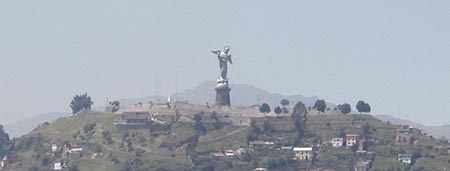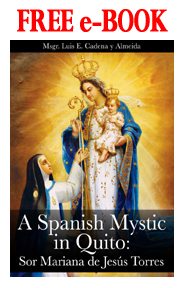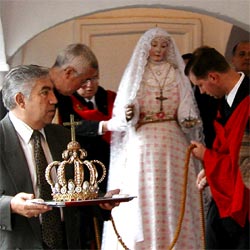
On a pilgrimage to visit the miraculous statue of Our Lady of Good Success, I embarked for Quito, Ecuador with great expectations.
Part of my task in taking part in this TFP pilgrimage was to help with the solemnities of her February 2 feast. However, I also hoped to immerse myself in what was once a truly Catholic culture. I wanted to imbibe the supernatural in this city filled with convents and churches.
All the elements were certainly there. High atop Panecillo Hill, the towering statue of Our Lady of Quito could be seen throughout the city. In the square-mile historical center, there is not only a huge domed cathedral but at least ten massive conventual churches representing Dominicans, Jesuits, Augustinians, Mercedarians, Franciscans, Carmelites, Conceptionists and others All these churches are architectural marvels, many dating from the sixteenth century. Each could nobly serve as a cathedral in any American diocese.![]()
FREE e-Book: A Spanish Mystic in Quito
I was pleased to see that many of these churches are in good repair. Nearly all are undergoing major restorations. The Jesuit Church in downtown Quito has the most beautiful and awe-inspiring woodwork I have ever seen. Gold covers not only the altars but the whole ceiling. Workmen were busy restoring the gold-leafing to its original and radiant splendor.
Everything was set for a glorious pilgrimage. However, after visiting a few of these churches on the first day, I was perplexed and disappointed.
Restorations Without Grace
Perhaps the restorations themselves were part of the problem. I was told that world organizations were pouring money into these restorations both to preserve them and contribute to the city’s tourist attractions. Quito was actually named the first UNESCO World Heritage Site.
While the restorations were well done, I felt they were almost archeological endeavors totally disconnected from Catholic worship. The same concern for historical detail could just as easily apply to an ancient Buddhist pagoda or an Incan temple. Indeed, the admission fees charged to enter some churches did little to dispel the impression of a museum-like atmosphere.
 Learn All About the Prophecies of Our Lady of Good Success About Our Times
Learn All About the Prophecies of Our Lady of Good Success About Our Times
I was told to be sure to visit the Cathedral’s crypt where the saintly anti-liberal president and martyr Garcia Moreno is buried. Entering beneath, I found the floor covered with dirt. Straw and hay were strewn about. Boards and old debris were haphazardly placed near the walls. The once immaculate crypt, where I had hoped to pray, was now presented in this manner to give it a “sixteenth century look.”
Another factor that added to my perplexity is the fact that Quito is a modern city. It suffers from the same errors, indecent fashions and loose morals of any city in our days. At first glance, the modern masses that crowded the busy streets seemed so out of context with these great monuments of the past.
I had seen the great church buildings but I longed to know the kind of Catholic souls that built these churches and gave them their true meaning.
A Prayer Heard
It was almost by accident that Our Lady granted my wish.
As part of the activities of this TFP pilgrimage, I was asked to help resurrect an old traditional procession called the “Rosary of the Dawn.” A small replica of the statue of Our Lady of Good Success had long been carried through the streets of downtown Quito on the dawn of her feast while the people prayed the rosary and sang hymns. With the passage of the years, the procession had dwindled to a few dozen faithful.
A few days before the feast, I was happily recruited to distribute invitations to the “Rosary of the Dawn” at the doors of churches. With my broken Spanish, I began to talk to Ecuadorian Catholics and change my superficial perspective. In the weathered and suffered faces of those who passed by, I began to see the glimmer of a profoundly religious people.
We hoped at least some of these Catholics might attend the early morning procession and intensified our efforts over the next few days hardly knowing what to expect.
The Rosary of the Dawn
At 4:30 a.m. on the day of the procession, we gathered before Our Lady in the darkened Church praying for “good success.”
As five o’clock neared, the first groups of people slowly filtered in. They soon started coming in spurts and then in torrents – people of all ages, men, women and children, fragile elderly ladies, husky men and young students. Whole communities of religious nuns filed in until we were astonished to see the church jammed with nearly a thousand people.
Before Quito awoke, the procession formed outside and Our Lady returned to parade in triumph through the main streets and central square.
Learn All About Sr. Mariana de Jesus Torres
It was then that I saw that my wish was granted. I had a privileged place in the procession right next to the statue helping to direct the litter bearers amid the crowd. As I looked upon the sea of Ecuadorian faces, I saw their supreme jubilation. We were showered (if not pelted) with rose petals in a display of contagious Latin exuberance.
It was as if the people were unshackled from their modern miseries and, forgetting themselves, now only thought of their queen and mother. The somber strains of the Spanish hymns filled the streets speaking of a tender child-like devotion:
O my mother who art in heaven
Send counsels to my heart
And when sad, weeping I call upon thee
And thy sweet blessings thou will bestow.
For a brief moment, I had a glimpse of the kind of Catholic souls that built those great churches. When a whole society is imbued with this kind of enthusiasm for the Faith, its churches rise to heaven… and heaven comes down to earth.

A Heavenly Link
If Quito is privileged to many miracles and apparitions, it is because heaven could not forsake devotion like I had seen.
Indeed, in those colonial times, heaven did come down to earth. That is why you can see in its churches the places where miracles happened through particular statues and devotions. That is why the Blessed Mother appeared on so many occasions to look after her children. It is as if there was a constant intercommunication between heaven and earth.
While such a link is not as evident today, the unction of that relationship still pervades in the city. You can see it in the touching popular devotion to Christ, bloody and scourged, in His Passion under invocations like Christ of the Great Strength or Our Lord of the Divine Love. You can see it in the “unrestored” side altars full of flowers, candles and testimonies of graces received. Indeed, the charm that attracts one to Quito lies in what remains of this link to heaven.
Our Lady of Good Success
Finally, there is Our Lady of Good Success, the object of my pilgrimage. It is an extraordinary statue resulting from a heavenly visit to Sister Mariana de Jesus Torres in 1610 at the Conceptionist Convent. Her prophecies are specifically about our own tragic days.
Although personal impressions may differ, I must say she far exceeded my expectations.
Although extremely maternal, she appears more as a queen than a mother. Everything about her is regal and majestic. She seems to be in lofty contemplation yet completely in control of everything around her. She appears sad not because of anything done to her, but by our failure to have recourse to her as queen.
She did not inspire in me a desire to ask for small things or favors. As all- powerful queen, she invites us to ask for great things – an end to the crisis inside the Church, a major conversion, a change of heart, or help in our personal struggle against so many things destroying society.
Yet her message is one of hope — good success. Her prophecies speak of times when she will again be recognized as queen.
I left Quito with my great expectations satisfied. I left with the certainty that we will see our great queen parading in triumph in city streets and squares. It will come about not through the sterile restorations of old buildings but the fruitful restoration of Catholic souls from which will come her reign foreseen at Fatima.

